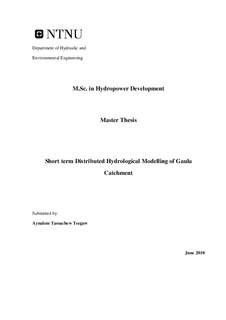| dc.contributor.author | Tsegaw, Aynalem Tassachew | nb_NO |
| dc.date.accessioned | 2014-12-19T12:31:22Z | |
| dc.date.available | 2014-12-19T12:31:22Z | |
| dc.date.created | 2011-05-23 | nb_NO |
| dc.date.issued | 2010 | nb_NO |
| dc.identifier | 418586 | nb_NO |
| dc.identifier.uri | http://hdl.handle.net/11250/242134 | |
| dc.description.abstract | Testing and trying out of the applicability and utility of watershed hydrological models in different; catchment sizes, hydro-geologic conditions, soil conditions and with different time resolutions is necessary for a range of spatial scales to assess the utility of these models in water shade management means like flood protection, land slide prevention, erosion control etc. The main purpose of this thesis is to tryout TOPLAND hydrological model, i.e. the new developments to the LANDPINE model allowing for using TOPMODEL distributed runoff generation, with different precipitation input methods. It focuses on the simulation of precipitation events with time resolution of one hour. Short term time resolution event simulations are important to capture flow events in small and large catchments; since these events are responsible for local flood, land slide etc., especially in areas where they are strongly localized. The model simulation has been carried out using three different precipitation input methods; gauge IDW interpolation, gauge simulated and radar based precipitation data for the selected hourly events of 2006 (27-07-2006 00:00 to 29-07-2006 23:00) and 2009 (19-07-2009 05:00 to 25-07-2009 20:00).
2009 Event
The 2009 event is characterized by high peak and uniformly distributed event. For the bias corrected radar precipitation, the objective method of result comparison showed an excellent correspondence between observed and simulated flows with NS (R2) of 0.98, correlation (R2) of 0.98 and PBIAS of 0.48% at the calibration point (Gaulfoss). The bias corrected radar precipitation also showed a very good performance of the model at the interior uncalibrated gauging stations with average values of NS (R2) 0.85, correlation (R2) 0.93 and PBIAS 16.6% of the HugdalBru, Lillebudal and Eggafoss gauging stations. The gauge IDW interpolation and gauge simulated precipitation input methods also showed a very good performance of the model both at the calibration and internal uncalibrated gauging stations.
2006 Event
The 2006 event is characterized by low peak and unevenly distributed (localized) event. The bias corrected radar precipitation is the only precipitation input method that made possible for calibration of the model. The objective method of result comparison showed a very good result for NS (R2) of 0.96, correlation (R2) of 0.97 and PBIAS of 5.1% at the calibration point (Gaulfoss). At the internal uncalibrated gauging stations, the correlation and PBIAS showed a good performance with average correlation (R2) of 0.77 and PBIAS of 21.3% and a poor average NS (R2) of 0.3. | nb_NO |
| dc.language | eng | nb_NO |
| dc.publisher | Norges teknisk-naturvitenskapelige universitet, Fakultet for ingeniørvitenskap og teknologi, Institutt for vann- og miljøteknikk | nb_NO |
| dc.title | Short term Distributed Hydrological Modelling of Gaula Catchment | nb_NO |
| dc.type | Master thesis | nb_NO |
| dc.contributor.department | Norges teknisk-naturvitenskapelige universitet, Fakultet for ingeniørvitenskap og teknologi, Institutt for vann- og miljøteknikk | nb_NO |
